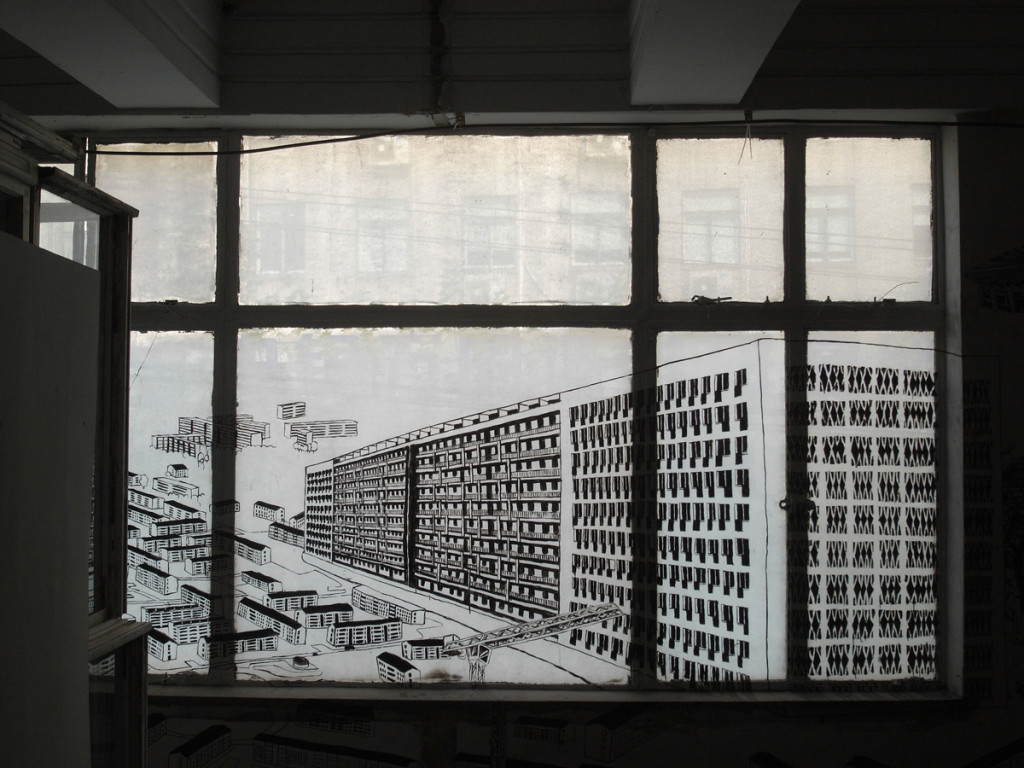I would like to follow up on my previous writings on the Shanghai Biennale 2012 and raumlaborberlin’s presentation in Shanghai in July 2012. One of the new approaches employed by the Biennale was the establishment of ‘city pavilions’. Raumlaborberlin, a German concept-architecture studio, has been in charge of the Berlin city pavilion.
The Berlin city pavilion has been located on the top floor of an empty house waiting for reconstruction on Nanjing East Road. The house as well as a few adjacent spaces has been reserved for miscellaneous city pavilions. Raumlaborberlin’s intention was to create a link between Halle-Neustadt and Shanghai using the common denominator of Richard Paulick, the chief architect of Halle-Neustadt, who has also lived and worked in Shanghai for a number of years.
Raumlabor took old window frames from one of the buildings in Halle-Neustadt, transported them to Shanghai, and transformed them into a new form – that of a Chinese teahouse – modeled after a reduced-scale modernist family house design. The visitor entered the space through a circle-shaped hole in an erected faux wall – a similar shape as can be seen in traditional Chinese gardens. Next, the visitor was standing in front of a slightly maze-like construction that was completely assembled of the recycled window frames from Halle-Neustadt. The construction gave a very light impression, thanks to all the transparent glass surfaces, combined with white window-frames; there was continuity between the inside and the outside. In the internal space, there was an improvised self-serve teahouse: Little chairs and tables, a hot-water machine and a box of green tea. Visitors could sit down and brew their own drink. Outside of the enclosed space, the windows of the actual building housing the whole exhibition were coved with while translucent paper. Raumlabor traced scenes of cityscapes from Halle-Neustadt onto these with black and white markers. The drawings extended on the white walls adjacent to the windows as well.
In raumlaborberlin’s installation, I could see the connection between Halle-Neustadt and a generic Chinese theme, but the connection to Shanghai was less obvious. Given the fact that on one side of the Berlin-Shanghai bridge there was the strong and well researched image of Halle-Neustadt, it would be nice if this image could be coupled with a similarly strong image of Shanghai. The transformation of old windows into a (functionally) traditional Chinese teahouse can rather be seen as a connection between two kinds of utopias, both of a completely different kind. Halle-Neustadt as a functionalist-socialist utopia of an engineered architecture contrasted with the fictional narrative of China as the teahouse-culture country, cherishing both modernity and tradition. The already dismantled parts of the Halle-Neustadt utopia are used as a support of a ‘traditional China’ narrative. Why do I refer the ‘traditional China’ narrative as fictional? The teahouse in the top floor of a derelict building scheduled for reconstruction, located the Shanghai’s most crowded shopping street seemed completely out of place. There are not many teahouses in Shanghai, and it seems that all that inhabitants of Shanghai strive for today is a KFC chicken leg or a Starbucks coffee. A teahouse is referring to a culture that has basically disappeared already.
The location of the building was equally problematic. I can imagine that raumlabor would probably much more prefer to set up the teahouse in the park on People’s Square, but that they were not allowed to do that given the fact who the rulers of Shanghai (and whole China) and their interests are. I see this as the main weakness of the project: Raumlabor’s projects usually try to engage and empower people to participate and make decisions about the design of their living environment on their own. Unfortunately this is completely alien to China were obedience to leaders and creativity expressed through copying ‘masters’ still seems to be the preferred (and enforced) mode of existence. Even setting up a ‘temporary autonomous zone’ in the form of a teahouse on a public square would probably be perceived as a too big ‘disruption of public order’. Instead, contemporary art is ghettoized into ‘special areas’ of unused real estate. The off-centre location of art spaces itself is common elsewhere as well, but raumlabor’s products (this project too) are not really objects to be put in an art space for observation, but they are sculptures with a social function, sculptures to be used and engaged with actively. And this mode of engagement is much more easily achieved in a public space.
The work still provided an intellectual stimulus to ponder over the rise and fall of utopian models, or modes of engagement with an architectural space; it provided numerous layers of meaning. However exhibiting it in a gallery setting was working against the author’s intention (I think) and limited the audience severely. I am inclined to attribute this problem to the overall situation of the Biennale, Shanghai and China. Raumlaborberlin probably did their best given the circumstances they were in.
